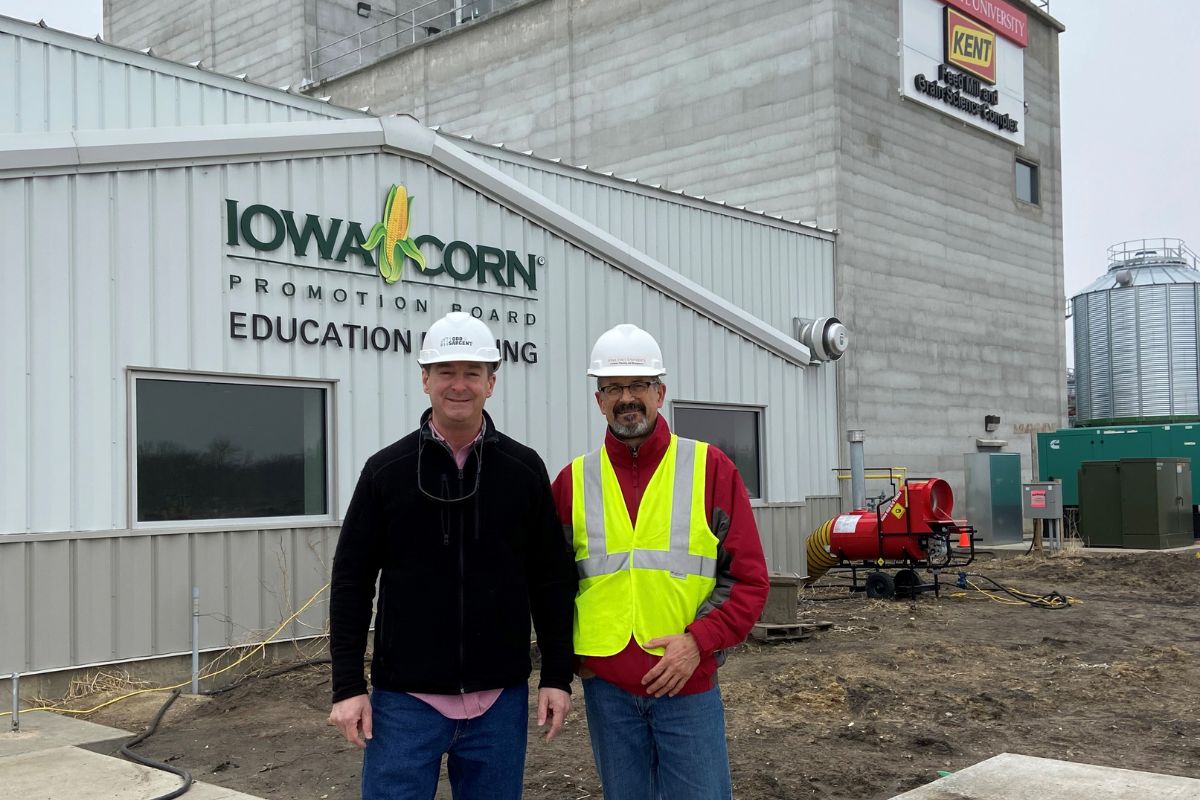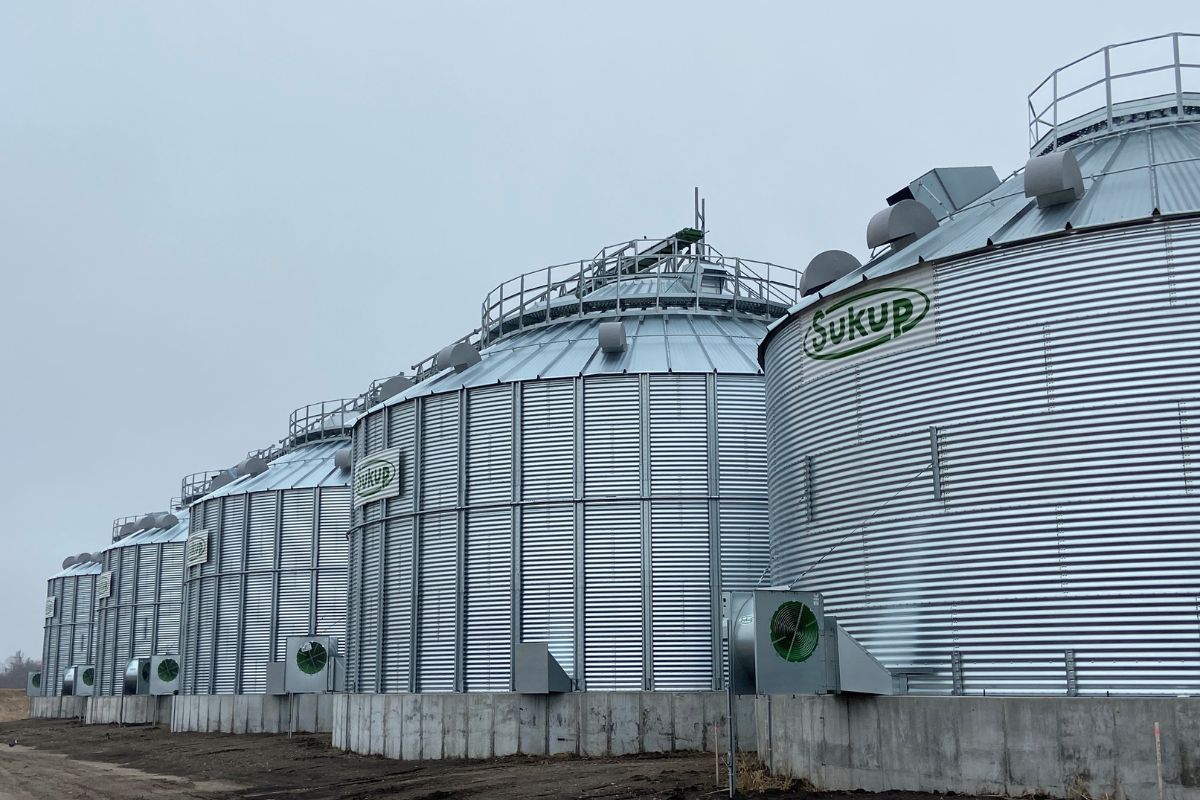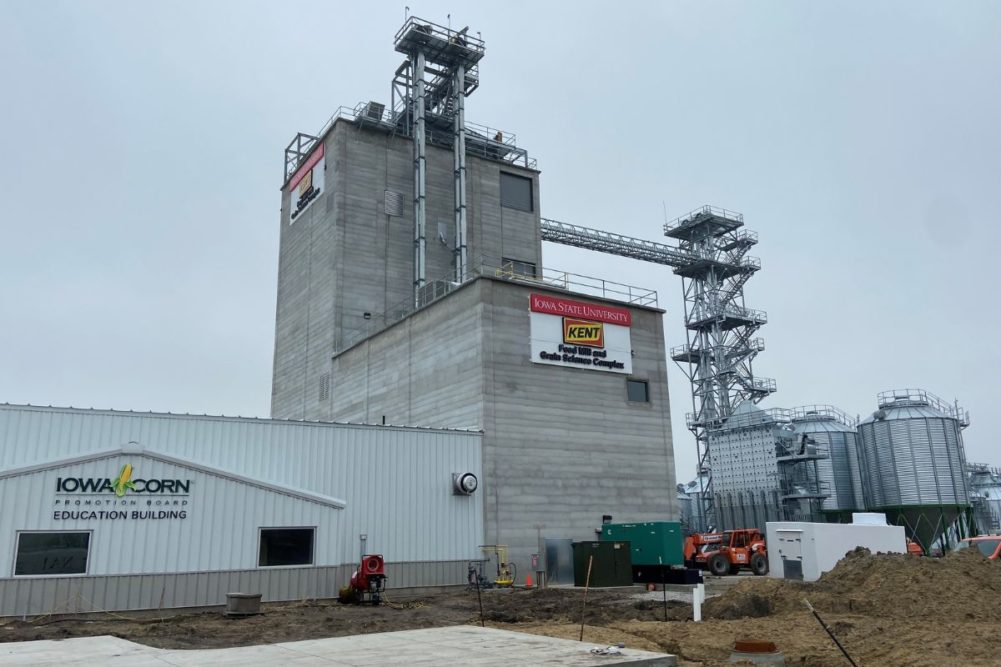AMES, IOWA, US – While it can produce up to 30,000 tonnes of feed and store more than 200,000 bushels of grain, the most important “commodity” to come out of the Iowa State University Kent Feed Mill and Grain Science Complex will be job-ready people with hands-on experience.
“We’re really good at teaching people how to think, and now hopefully we can give them the skills behind it,” said Anthony Ewing, who has 30 years of experience in the feed industry and has been manager and associate director of the facility for the last two years. “There are a lot of places teaching this is a pellet mill; we’ll take them to the next level. They’re learning leadership, how to make decisions on the fly, all the things they would typically have to wait until they got into industry to do. That’s invaluable.”
The grain storage and feed milling complex located on 10 acres of university farmland in Ames, Iowa, US, will open in phases starting this summer. Initial planning for the facility started in 2015 and construction began in fall 2019. Its development and construction were possible because of the financial investment and support from the feed and grain industries, the university and equipment manufacturers, said Dirk Maier, director of the complex and professor of agricultural and biosystems engineering at ISU.
“There are a lot of places teaching this is a pellet mill; we’ll take them to the next level.” - Anthony Ewing, manager and associate director of the facility
“The companies that we’ve worked with to make this project happen have all done a tremendous job,” said Maier, a longtime educator and renowned expert in grain storage and handling, who has extensive experience in developing public-private funded university-based training facilities. “When you come and visit this facility, you will see a state-of-the art facility that is put together in an unbelievably outstanding way. That goes to the workers and the workmanship of the companies that have been involved.”
Several major donors joined in the $32+ million project early on including Kent Corp., Muscatine, Iowa, US, with $8 million; the Iowa Corn Promotion Board with $4 million; and Sukup Manufacturing, Sheffield, Iowa, US, with $3 million. Other major donors included California Pellet Mill (CPM), Waterloo, Iowa, US, which provided $2.6 million in equipment, automation and services and Todd & Sargent, based in Ames, which served as general contractor.
Along with hands-on training and developing new workers for the feed and grain industry, the complex will offer training and research opportunities for both industries. The 47,000-square-foot complex includes a warehouse and educational building with a 50-person classroom, analytical laboratory and pilot plant; a 100-foot-tall concrete milling tower and 40-foot-tall pelleting plant; and 220,000 bushels of steel grain storage with handling and drying systems.
Feed production, which will include commercial feed as well as feed for ISU’s Research and Demonstration Farms, will start this summer. The grain portion of the complex will be ready for harvest this fall, Maier said.
“We’re open for business,” he said. “Whether it has to do with research capabilities, diet preparation or more, call us. The facility is available to utilize, to do training here, to partner with. Also, partner with us in helping attract, recruit and prepare the talent that the industry is interested in. This facility is not so much about making feed; it’s about preparing students for the industry.”

A 30-year industry veteran, Anthony Ewing, right, is associate director and operations manager for the facility, and Dirk Maier, left, is director of the complex and professor of grain and feed operations and processing at Iowa State University.
|
Future workforce
When Maier came to ISU in 2015, while the College of Agriculture was investigating plans for its feed facilities, he was interested in building a program, not just a mill. Part of the program was the addition of a minor in feed technology, introduced in 2019, which includes specialized classes that will utilize the new complex.
The feed technology minor can be added onto multiple degrees programs from the College of Agriculture, such as animal science, ag technology or ag education. Currently, there are 16 students enrolled in the minor, a number that Maier expects will grow once the facility is operational.
“They’ll get exposed to the industry earlier and we can build a stream with regard to internships,” he said.
Even before opening, the facility has been used by engineering and project management classes, Ewing said. Grain preservation and ag engineering classes also will utilize it for labs on grain drying, handling, processing and more.
“One of the key challenges is to help faculty understand the capabilities and possibilities and set it up in such a way that it’s easy for them to bring their classes,” Maier said.
The facility will be almost completely run by students, who will learn not just the technical aspects of feed mill operation but other skills that usually don’t come until the first year on the job.
The facility will be almost completely run by students, Ewing said, who will learn not just the technical aspects of feed mill operation but other skills that usually don’t come until the first year on the job.
“From the industry standpoint, they can skip over that first year, if they’ve been in this facility,” Ewing said. “That’s pretty big for a company to say all we have to do is introduce you to our culture and you’re job ready.”
Maier envisions opening the facility in some way to community college students. During COVID, the university learned how to make learning accessible. Maier has taught classes that included 15 students in person and another 14 online in real-time in Africa and Europe.
“You could include community colleges in that,” he said. “They could come here on weekends or other time periods and get their hands on the components. We’ve got to continue to think with an open mind and remain flexible. How do we get people trained?”
Industry use is another key aspect of the facility, and Ewing and Maier said they are ready and willing to work with companies to meet their individual needs.
“It’s a full range of options from the types of training we offer, to custom training or closed training for just one company or making the facility available to a company and we’re just the support personnel,” Maier said.
They already have received numerous inquiries from industry, Ewing said.
“I don’t think there’s been a training opportunity that we’ve said no to,” he said. “There are all kinds of combinations people have asked about. We will find a way.”

Each bin has a capacity of about 45,000 bushels, with two different aeration systems so comparisons can be made for research purposes.
|
Facility details
The ISU complex is unique in that it combines the training, educational and research objectives of grain storage and handling, with feed.
“We wanted to make sure with this facility that we met the needs and opportunities related to grain handling operations, both in terms of equipment and operationally speaking,” Maier said. “Feed manufacturing from day one can run independently of the grain center and vice versa. That’s really a unique aspect, both from the education side as well as the research opportunities we have in this regard, too.”
The facility is currently looking for grain origination partners that would be able to provide it with corn on a weekly basis for processing. There are five co-op facilities within a 10-mile radius of the facility, so there’s plenty available, Maier said.
Available storage includes four 45,000-bushel steel bins, each 54 feet in diameter. Two of the bins are equipped with a lower range of air flow rates and two have higher ranges.
“We have a big range so that we can make comparisons,” Maier said. “They are also set up to be accessible so they can be used for grain safety training as well.”
All the bins have temperature, moisture and carbon dioxide sensing systems as well as automatic fan control and exhaust systems. Another 20,000-bushel bin is equipped with an in-bin drying system with a stirring machine. Two additional 10,000-bushel bins will provide wet storage ahead of a 2,000-bph mixed-flow dryer. Sukup donated all equipment and covered the installation costs.
The equipment relates well to what students will encounter whether they return to family farms or join the grain industry after graduation, Maier said.
SLIDESHOW: ISU feed, grain complex nears completion
“A big goal of ours will be helping people understand that with reasonably affordable technology you can basically keep monitoring and maintaining the quality of stored grain,” he said.
The feed milling portion of the facility includes the main 100-foot-tall concrete tower slip formed by Todd & Sargent in four and a half days using two crews, working 12-hour shifts. Each group of about 70 people averaged roughly 12 feet per shift.
A second 40-foot-tall concrete tower houses the pelleting plant. CPM donated a large portion of the feed milling equipment, including a 10-tph, three-high roller miller, a 10-tph hammermill, a 24-bin microingredient system and a 5-tph conditioning, hygienizing, pelleting and counterflow cooling system. CPM Automation provided the automation for the feed mill and CPM Bliss Industries donated a high-efficiency pellet cooler. AGI SureTrack supplied the hazard monitoring and stored grain management system.
The parallel conditioning line is unique in that one conditioner can feed into the pellet mill or bypass it, and the other conditioner with retentioner can hold feed at high temperatures for a longer time to produce either pelleted feed or heat-treated mash.
“There’s a lot of work that is going to be done in these lines, whether it’s feed safety work or steam research,” Ewing said. “You hear people say pelleting is an art. We hope to take some of the art out of it and make it a little more science.”
The feed mill can produce 30,000 tonnes of feed per year, with 5,000 to 6,000 tonnes for university use and the rest for commercial purposes.
The facility also includes a 30-tph twin-ribbon mixer for batching and mixing that was donated by Scott and a central vacuum system that was donated by Walinga, Guelph, Ontario, Canada.
The feed mill can produce 30,000 tonnes of feed per year, with 5,000 to 6,000 tonnes for university use and the rest for commercial purposes. If the university needs increases, output can be adjusted, Ewing said.
Within the Iowa Corn Education building, the pilot plant will include a 1-ton pellet mill; 50-, 250- and 500-pound mixers; a micro dosing system; a small roller mill; a small hammermill; and a conveying system that can be flushed out with hot water and disinfected in between use. It will be used for research and training as well as producing poultry feed for university use.
The small scale of the pilot mill makes it ideal for all the research that isn’t cost-effective or feasible on a full-scale commercial mill. The smaller sized equipment is also less intimidating to students, Ewing said.
“Dealing with things that are really big tends to intimidate people,” he said. “That ability to introduce people to things that aren’t towering over them, they can lay hands on it, open it up, makes it much easier to teach them. It’s just a different environment.”
The educational building includes a classroom and an analytical lab with space enough for a class of students, providing more hands-on opportunities. Different levels of biosecurity protocols will be possible, including shower-in/shower-out, or completely shutting down public access to the feed mill.
With the facility on the cusp of opening, Ewing and Maier said they’ve met most of their needs for physical equipment. What’s needed now is people.
“My most expensive thing is going to be labor,” Ewing said. “That’s what we need at this point. The more labor I have, the better. I could run it with one person but that’s not the point.”
Sponsoring a student’s apprenticeship at the facility creates a perfect synergy, introducing students and feed companies to each other much earlier, opening even more opportunities prior to graduation.
“They’ll be able to have a conversation with a student earlier on and maybe offer them an internship at their company,” Maier said. “If we have multiple companies that are sponsoring students with us, it helps us fulfill our purpose, which is giving more students the opportunity to get hands-on training experience.”






